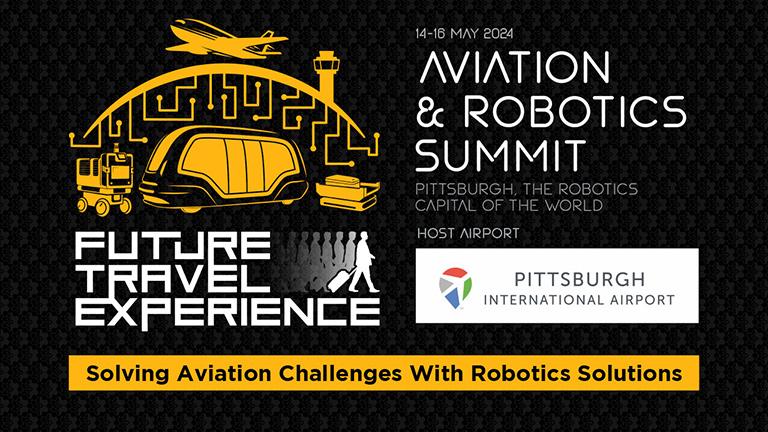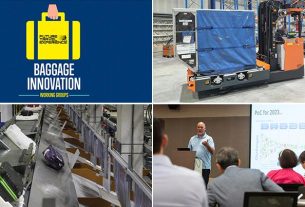We are in the middle of a robotics revolution. Robotics technologies and automation can help to solve some of the air transport industry’s biggest challenges, while facilitating more personalised customer experiences and enhancing operational efficiencies. In part 1 of our extensive focus on robotics and automation – ahead of the FTE Aviation & Robotics Summit taking place in Pittsburgh on 14-16 May 2024 – Brian Cobb, Chief Innovation Officer, Cincinnati/Northern Kentucky International Airport; Cole Wolfson, Director, xBridge, Pittsburgh International Airport; Alice Tosti, Acceleration Program & Open Innovation Specialist, Aeroporti di Roma; and Abhi Chacko, Head of Innovation, London Gatwick, share their insights into the latest developments and trends in this realm.
CVG: “Our robotics and autonomous programmes are a progressive socialisation of these technologies”
Cincinnati/Northern Kentucky International Airport (CVG) – a Corporate Partner of the FTE Digital, Innovation & Startup Hub, which is focusing on AI, robotics and IoT throughout 2024 – is among the most progressive in the robotics and automation space. As Future Travel Experience recently reported in this article, a great example is International Airlines Group (IAG) – parent company of British Airways, Iberia, Aer Lingus, Vueling and LEVEL – and Aurrigo commencing deployment and demonstration of the Auto-DollyTug autonomous baggage tractor at CVG.

“Our role at CVG is to serve as the host and onsite support since this is taking place on our airfield,” says Brian Cobb, Chief Innovation Officer, Cincinnati/Northern Kentucky International Airport. “We are assisting with things like mapping the route for the vehicle, providing space for the team to work, introducing the partners to other stakeholders, and ensuring the airport community throughout our campus can learn and benefit from the programme. We passed an ordinance years ago to empower our tenants to explore new autonomous technologies to have a safe and efficient campus. We are proud of our previous work with ThorDrive’s retrofitted autonomous tug, which helped increase comfort levels with automation in the non-movement area.”
CVG has utilised autonomous floor scrubbers for many years now and has also partnered with Ottonomy to trial its food and goods delivery robots. “The first trial was for delivery of travel essentials and grab-and-go items in a concourse predominantly used by business travellers,” Cobb explains. “Our second trial was delivery of Subway food items in a concourse predominantly used by leisure travellers. The learnings from both helped guide the improvements of the robot you see working today in many airports and campuses.”
Another fun, but slightly different robot that CVG brought to the airport environment in early 2020 is GITA by Piaggio Fast Forward. This is a following robot that CVG tested for movement of passengers’ bags and the airport has fully adopted the technology for its customer experience teams to use while engaging with passengers on feedback and surveys.
“We are in constant communication with tech companies, and you will see us introducing more technologies that allow our teams to focus on the higher touch, more skilled part of their jobs and allow the robotics to provide them the freedom to do so,” says Cobb. “We have also explored other robotics such as lawn care, passenger assistance, operations tools, and more. Our robotics and autonomous programmes are a progressive socialisation of these technologies, demonstrating how we can collaboratively push the aviation ecosystem forward for improved operational efficiencies, workforce upskilling opportunities, and guest experiences.”
PIT actively pursuing trials of ecosystems of autonomous technologies
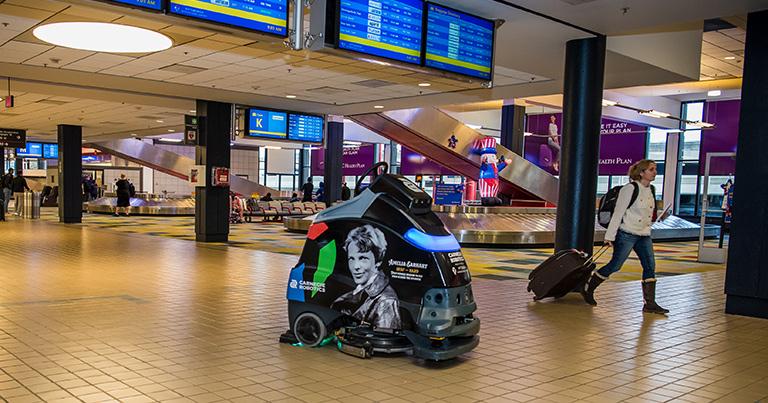
Pittsburgh is known as the “Robotics Capital of the World” and Pittsburgh International Airport (PIT) – a Corporate Partner of the FTE Digital, Innovation & Startup Hub – is host airport of the FTE Aviation & Robotics Summit, taking place on 14-16 May 2024.

“At PIT, we’ve done several trials of various autonomous and autonomy-enabling technologies over the past two years,” explains Cole Wolfson, Director, xBridge, Pittsburgh International Airport. “These trials have been confined to the terminal, parking lots, and other passenger-facing areas, as the challenges of implementation are lessened when these vehicles are not around aircraft. Now that we’ve refined our processes and formalised partnerships with a few airlines, we’re beginning to move toward testing autonomous technologies on the airfield, prioritising below-wing functions and support.”
In terms of trends, PIT is starting to see – and is actively pursuing trials of – ecosystems of autonomous technologies. “Functional technologies that do one thing really well are relatively prevalent; integrating these technologies to work together in a controlled environment is, I believe, the largest near-term challenge,” Wolfson shares.
Autonomy can support workers and improve job conditions, with high-volume repetitive operations that can be automated. “In dynamic real-world environments, however, there are always surprises: emergent events, edge-cases, new form factors, etc, that require the judgement and intervention of humans,” Wolfson notes. “In improving working conditions and job scopes, we are also enhancing the passenger experience: efficiencies in plane turns and servicing allow for more timely departures and less waterfall-effect delays throughout the system.”
ADR: “Robotics and autonomous vehicles will rethink airport operations to build a smart and interconnected ecosystem”
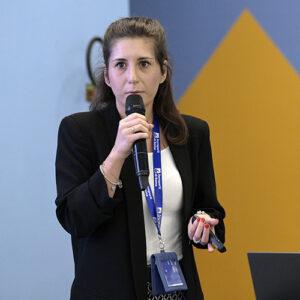
As Future Travel Experience recently reported in this interview, Aeroporti di Roma (ADR) – a Corporate Partner of the FTE Digital, Innovation & Startup Hub – has launched a third ‘Call4Startups’ as part of its ‘Runway to the Future Acceleration Program’. ADR is empowering the next generation of disruptors with the opportunity to embark on an eight-month journey to develop a Proof of Concept, testing their solution within the ADR Innovation Hub at Rome Fiumicino Airport, with the deadline to apply being 22 March 2024.
“We’ve launched our third global ‘Call4Startups’ with the aim of discovering cutting-edge robotics technologies,” says Alice Tosti, Acceleration Program & Open Innovation Specialist, Aeroporti di Roma. “We strongly believe that robotics and autonomous vehicles will be able to rethink airport operations to build a smart and interconnected ecosystem.”
In order to do this, Tosti explains that in the ‘Smart Operations & Processes Challenge’ as part of the ‘Call4Startups’ ADR looking to the following trends:
- Robotics: “Solutions to support operators in the performance of repetitive or physically intensive tasks. Use of wearable technologies to support operators and introduction of robotics in airport processes in order to improve existing processes.”
- Autonomous operations: “Development of solutions based on autonomous or remotely controlled systems for transport or for the management of technical activities outside and inside terminals. Specifically, we seek solutions in the context of baggage handling, PRM (passengers with reduced mobility) management and for all passenger security and check-in activities.”
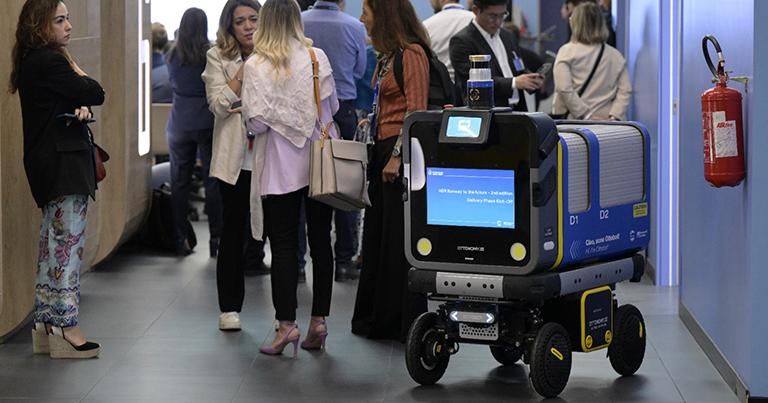
One standout success from ADR’s first ‘Call4Startups’ is its partnership with Ottonomy and its autonomous robot delivery solutions for both food and retail products. “With Ottonomy’s innovative technology, customers now have the convenience of making purchases either through an intuitive online platform or directly in-store, with seamless delivery straight to their designated location, including doorstep and gate delivery options,” Tosti comments. “This collaboration marks a significant stride towards shaping the future of retail and delivery services, enhancing convenience, efficiency, and customer engagement in unprecedented ways.”
Currently, ADR is testing two autonomous wheelchairs directly inside Terminal 1 and Terminal 3 at Rome Fiumicino Airport. “We tested the service on more than 180 passengers to validate directly with them the possibility to provide a smooth and reliable service,” Tosti adds. “Besides that, we are testing an autonomous robot able to sweep and collect FOD (foreign object debris) on aircraft aprons; our aim while testing this robot is to test unmanned airside safety solutions and improve the information management process by sending immediate safety critical information.”
LGW: “Embracing this technology and implementing it alongside our workforce is essential to enhancing the passenger experience”

London Gatwick believes a lot of airfield activities can be done using autonomous technologies in the future. “We are planning to trial autonomous baggage transfer from baggage hall to aircraft later this year,” explains Abhi Chacko, Head of Innovation, London Gatwick. “We will be adding autonomous tech to jet bridges, enabling certain functions to be performed autonomously. We are also exploring whether we can use a robot to clear FOD (foreign object debris) on stand, freeing up our staff to focus on other tasks.”
Embracing robotics and autonomous technologies, and implementing them alongside the workforce, is essential to enhancing the passenger experience. Chacko adds that, if autonomous vehicles are deployed on repetitive operational activities, it can reduce cost. “It can also improve safety and reduce the chance of accidental damages. Robotics technology can also avoid the need for specialist and time-consuming training such as jet bridge operations. In certain cases, such as passenger transport, deploying robotic vehicles can extend the service hours, in addition to reducing the time passengers have to wait.”
FTE Aviation & Robotics Summit to take place in Pittsburgh, 14-16 May 2024
Learn more about robotics at the FTE Aviation & Robotics Summit, taking place in Pittsburgh – the “Robotics Capital of the World” – on 14-16 May 2024.
The FTE Aviation & Robotics Summit 2024 will bring together aviation and robotics industry professionals with the primary goal of solving aviation business and operational challenges with robotics solutions. The three-day interdisciplinary series of conference sessions, workshops, robotics innovation tours, and networking opportunities will take place across the city of Pittsburgh. The workshops will be hosted at the renowned Carnegie Mellon University (CMU) – one of the top robotics and computer science universities in the world.
To meet phenomenal demand for insights and learning in this realm, the 2024 event will be open to all industry executives with a definitive focus on robotics and AI – technologies which we are convinced will reimagine the aviation sector within the next five to 10 years.
There are a total of 100 complimentary tickets available for direct employees of Airports, Airlines, Aircraft Manufacturers and Government Agencies, who must express their interest by Thursday 29 February in order to be considered for a free ticket. In addition, we have 100 tickets available for Vendors/Suppliers.
Register / express your interest in the FTE Aviation & Robotics Summit 2024 >>

